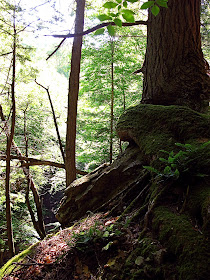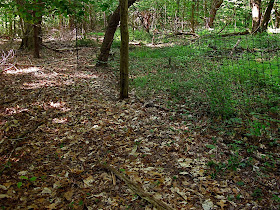
Blue sky, still water: the morning beckons at Pyramid Lake in the Adirondacks.
In my last post I promised lots of flower photos from my weekend at Pyramid Lake. Every Memorial Day Weekend up there for at least 15 years I have found such interesting flowers as Purple Virgin's Bower, Rose Twisted Stalk, and Creeping Snowberry, but not this year. This year, because of our super mild spring, they had bloomed weeks before, so all I could find were their leaves and maybe some seeds. Here's a nice growth of Creeping Snowberry, shiny and pretty even without its tiny flowers, which are hard to see even when present.
 Update: a commenter named Jules has ID'd this as an Arctic Skipper, which mostly strays into only our northernmost states.
Update: a commenter named Jules has ID'd this as an Arctic Skipper, which mostly strays into only our northernmost states.
At least Bunchberry still had its lovely white flowers, and it covered the rocks in profusion.
Was I disappointed when I couldn't find my old favorites? Well, sure, a little. But I still had a wonderful time, paddling a pristine wilderness lake and walking about in the Adirondack woods. And guess what? NO BLACK FLIES!!! Like the wildflowers whose blooms I could not find, they seemed to have come and gone.
There were lots of other bugs, however, including hordes of dragonflies zooming about the beach, gobbling up the mosquitoes before they could even land on us bathers. Here's a photo of one, a species I've never seen before and don't have a name for, either. Update: Tom Arbour left a comment suggesting this may be a Chalk-fronted Corporal, quite rare in his own state of Ohio, but abundant elsewhere. There certainly were a lot of them at Pyramid Lake.
I don't have a name for this cute little caterpillar, either, which was crawling across my pant-covered leg. Until I enlarged this photo on my computer, I had no idea it sprouted those bunches of white hairs. This creature was only about half an inch long.
Here are a couple of other unknowns, which I'm just too tired tonight to study my guide books to name. My weekend at camp wasn't just for fun: I vacuumed and dusted and scrubbed about 20 guest rooms and 10 bathrooms, for a start, so yes, I'm tired tonight. So maybe my readers will give us an ID on these pretty critters. First, a brown and orange butterfly:
 Update: a commenter named Jules has ID'd this as an Arctic Skipper, which mostly strays into only our northernmost states.
Update: a commenter named Jules has ID'd this as an Arctic Skipper, which mostly strays into only our northernmost states.And second, a furry brown moth. It actually stayed on the end of my finger while I took its photograph. I believe it is some kind of Sphinx Moth. Update: by searching the web, I found the Walnut Sphinx Moth looks very much like this one.
As I mentioned above, I did get out in my boat for a bit, heading out at dawn to paddle down into the marshy end of the lake where fallen logs form nursery beds for lots of interesting plants. Round-leaved Sundew is one of them. In this photo, the morning dew has added clear sparkly drops to the sundew's own red sticky ones.
Marsh Cinquefoil grows on the fallen logs, too, and its leaves were also sparkling with dew, one crystalline drop clinging to each serration of the leaves. Could a jeweler working with diamonds and jade create anything more beautiful?
Big, bright Yellow Pond Lily is always a busy spot for bugs.
Here's a log that sank a long time ago. I just loved the color and texture of the wood. There's often as much wonderful stuff to see underwater as there is on the surface or along the shore.
For example, look at these clusters of some critter's eggs, dangling and swaying beneath the water like tangles of light blue yarn. Whose do you think they are?
I paddled at sunset as well as at dawn, and last night I had a companion join me as my canoe rested against the dock that served as this spider's home.
Today I finished my work in time to head over to neighboring Eagle Lake, which empties into a stream that flows through a fen where some bog plants grow. And again, I missed the flowering period of most of the plants I seek here. I could find no sign of Bog Laurel, but I did find Bog Rosemary, whose new-formed berries are just as pretty and pink as its flowers were.
The Pitcher Plants were in their glory, their blooms plump as apples, with insides of gold and red. (Hmmm . . . Could a Pitcher Plant have served as a model for the Rolling Stones's "Forty Licks" album cover?)
Their water-filled pitchers, in various shades of green and yellow and red, are traps for enticing unwitting insects. But one dragonfly used this pitcher to launch its new air-borne life, leaving its nymph skin behind.
The stream's water level had fallen so low I had great difficulty approaching the boggy shore, so I headed out onto the lake. Eagle Lake has shores that are edged with steep rocky cliffs and monumental boulders topped with mosses, ferns, and in this case, a patch of Canada Mayflowers. And would you believe, still blooming?
If I hadn't decided to paddle the lake instead of the fen, I never would have seen these darling little Twinflowers, growing profusely -- and much earlier than ever before -- along the shore.
Bright clumps of Orange Hawkweed decorated the grass where I hauled my canoe ashore.
I still had time to stop off at Glen Lake on my way home this afternoon. My friend Sue had told me that One-flowered Cancerroot was blooming along the Warren County Bikeway, so I wanted to see if I could find it. On my first pass, I did not see it and so headed back, quite disappointed. And there it was. Hiding among the grasses.

















































